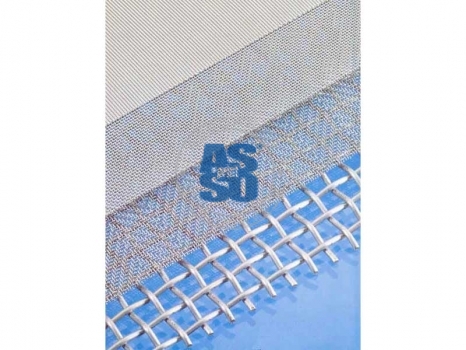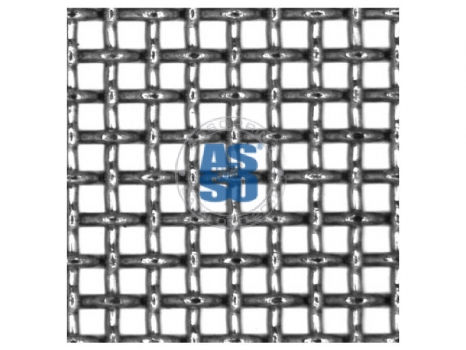STAINLESS STEEL SCREEN PRINTING FABRICS
| request |
|---|
USE:
Stainless steel fabrics for screening and screen printing meet the strictest requirements regarding diameter tolerance, structural strength and weaving surface.
DESCRIPTION AND FEATURES:
WEFT / WARP
 The longitudinal direction of a strip of fabric is termed warp, the transversal direction weft.
The longitudinal direction of a strip of fabric is termed warp, the transversal direction weft.
OPENING (w),
THREAD DIAMETER (d)
 The square mesh weaving is defined by mesh opening and thread diameter. The opening (w) is the distance between two weft or warp threads. The thread diameter (d) is the diameter of the thread before weaving, as afterwards it could change slightly.
The square mesh weaving is defined by mesh opening and thread diameter. The opening (w) is the distance between two weft or warp threads. The thread diameter (d) is the diameter of the thread before weaving, as afterwards it could change slightly.
MESH COUNT (THREADS)
 This is the number of threads per cm (n) or per English inch (Mesh. They are calculated as follows:
This is the number of threads per cm (n) or per English inch (Mesh. They are calculated as follows:
Mesh = 25.4 mm
__________________
w (mm) + d (mm)
n = 10 mm
__________________
w (mm) + d (mm)
OPEN AREA (A°)
 The open area is the sum of all openings expressed as the percentage of the total fabric surface. The larger the open surface of the metal fabric, the greater the quantity of ink that passes through.
The open area is the sum of all openings expressed as the percentage of the total fabric surface. The larger the open surface of the metal fabric, the greater the quantity of ink that passes through.
THREAD DIAMETER
 The choice of thread diameter is influenced by a series of factors. The thicker the thread, the sturdier and more abrasion-resistant is the fabric and the longer it lasts. On the other hand, thicker weaving reduces the open surface and therefore the flow.
The choice of thread diameter is influenced by a series of factors. The thicker the thread, the sturdier and more abrasion-resistant is the fabric and the longer it lasts. On the other hand, thicker weaving reduces the open surface and therefore the flow.
 For each mesh opening, a reduced thread diameter increases the number of openings.
For each mesh opening, a reduced thread diameter increases the number of openings.
 In many cases, the ideal specification is best identified through testing. As the open area directly or indirectly affects the flow as well as the expected life of the mesh, this data is listed in the tables on the following pages.
In many cases, the ideal specification is best identified through testing. As the open area directly or indirectly affects the flow as well as the expected life of the mesh, this data is listed in the tables on the following pages.
Stainless steel fabrics for screening and screen printing meet the strictest requirements regarding diameter tolerance, structural strength and weaving surface.
DESCRIPTION AND FEATURES:
WEFT / WARP
 The longitudinal direction of a strip of fabric is termed warp, the transversal direction weft.
The longitudinal direction of a strip of fabric is termed warp, the transversal direction weft.OPENING (w),
THREAD DIAMETER (d)
 The square mesh weaving is defined by mesh opening and thread diameter. The opening (w) is the distance between two weft or warp threads. The thread diameter (d) is the diameter of the thread before weaving, as afterwards it could change slightly.
The square mesh weaving is defined by mesh opening and thread diameter. The opening (w) is the distance between two weft or warp threads. The thread diameter (d) is the diameter of the thread before weaving, as afterwards it could change slightly.MESH COUNT (THREADS)
 This is the number of threads per cm (n) or per English inch (Mesh. They are calculated as follows:
This is the number of threads per cm (n) or per English inch (Mesh. They are calculated as follows:Mesh = 25.4 mm
__________________
w (mm) + d (mm)
n = 10 mm
__________________
w (mm) + d (mm)
OPEN AREA (A°)
 The open area is the sum of all openings expressed as the percentage of the total fabric surface. The larger the open surface of the metal fabric, the greater the quantity of ink that passes through.
The open area is the sum of all openings expressed as the percentage of the total fabric surface. The larger the open surface of the metal fabric, the greater the quantity of ink that passes through.THREAD DIAMETER
 The choice of thread diameter is influenced by a series of factors. The thicker the thread, the sturdier and more abrasion-resistant is the fabric and the longer it lasts. On the other hand, thicker weaving reduces the open surface and therefore the flow.
The choice of thread diameter is influenced by a series of factors. The thicker the thread, the sturdier and more abrasion-resistant is the fabric and the longer it lasts. On the other hand, thicker weaving reduces the open surface and therefore the flow. For each mesh opening, a reduced thread diameter increases the number of openings.
For each mesh opening, a reduced thread diameter increases the number of openings. In many cases, the ideal specification is best identified through testing. As the open area directly or indirectly affects the flow as well as the expected life of the mesh, this data is listed in the tables on the following pages.
In many cases, the ideal specification is best identified through testing. As the open area directly or indirectly affects the flow as well as the expected life of the mesh, this data is listed in the tables on the following pages.


